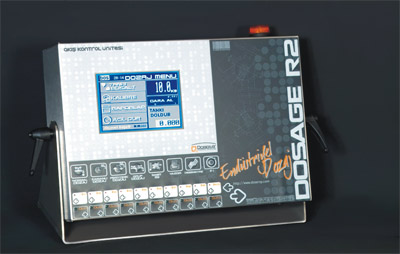Chemical
Structure of the Liquid;
Wet parts of the flowmeter (those parts in contact with the liquid)
should completely comply with the liquid for which it will be used.
This is possible only either by experience and knowledge of the fact
that it has been used for the same liquid previously or confirmation
of the suitability of the flowmeter from the chemical compatibility
schedules or confirmation by the manufacturing firm or approval by
the customer.
Viscosity/Fluidity of the Liquid:
Viscosity limits of the flowmeters vary depending on the operating
systems and their sizes, raw materials and trademarks. Temperature
and viscosity are inversely proportional. For this reason, care
should be shown when selecting flowmeter for high viscosity liquids.
For example, when a viscous liquid brought into the silo outdoor in
the summer temperature passes through the flowmeter, same liquid may
not pass through the flowmeter when the air gets cooler.
Turbine type flowmeters may be used for the low viscosity liquids.
Disc type flowmeters may be used for low and medium viscosity
liquids. Oval-gear, track, ring, piston and helix rotor types of
flowmeters may be used for low, medium and high viscosity liquids.
Operating Pressure; Minimum
Pressure: A minimum pressure is required for each flowmeter to
operate. This quantity may be above the value of pressure loss. It
is especially important on the lines where when the flowmeters
operate by the liquid’s own flow
Maximum Pressure: This is an upper limit specified according to the
design of the flowmeter. Excess of this limit gives damages to the
flowmeter. This value varies depending on the operating principle,
materials used and intended production purpose.
Operating and Ambient Temperature:
Ambient temperature: It means ambient temperature of the environment
where the flowmeter operates. It is a value that should be paid
attention especially in the hot environments such as boiler rooms
and in the very hot climates.
Operating Temperature: It is temperature of the liquid to pass
through the flowmeter. It varies depending on the materials and
types of indicators used on the flowmeter. Maximum and minimum
limits should be known.
Output Range (minimum and maximum flow rate):
Each flowmeter has a range of measuring. This value varies depending
on the operating system and indicator type of the meter. The rate
between the lower and upper limits is 1:10 or 1:20 in case of
turbine type flowmeters. It may be 1:100 in case of oval geared type
flowmeters. However, this rate is not related with the measuring
system completely. Type of indicator may also be determinant in this
respect.
LIQUID PROCESSES & Dosage
It is the easiest way to correctly and quickly weigh the conStituent
raw materials of your mixtures. Stability of the mixture rates
conStituting your products is directly proportional to the quality
of the work you perform.
You may think at first that raw material more than the required one
improves product quality. Or tolerance of the work you perform may
compensate such errors. In order to achieve this target and avoid of
any faulty mixture rate, small or high, you should use correct
methods and tools.

A smart device … Mini Dosing Panel
PLC, Touch Screen and durable membrane switch screen as the advanced
technology of our times.
Panel Sizes (w400 x d100 x h280mm).
* User-friendly calibration related to all liquids, whatever be
their viscosity. QuickCab.
* Compliance with the ever-changing flow rates thanks to the
volumetric measuring technique.
*Automatic line cut-off if automatic warning program is desired
against flowmeter faults at fixed flow rate.
* Compatibility with the pulse flowmeters, particularly, turbine
type and positive displacement flowmeters.
*Sensitive measuring by quick meter input for the high pulse
flowmeters (accuracy of 1000 pulse / 2 ml per liter by means of ½”)
*Dosing related to time function as the liquid passing in unit time
is fixed on the fixed flowrate lines without flowmeters.
* 4 relay outputs on the single- and double-action valves.
* Heating and cooling relay outputs designed to maintain fixed
temperature in the storage tank.
* Accuracy 0.5% - 1% depending on the selected type of flowmeter
* Service as counter on all kinds of inductive and capacitive sensor
* Password-protected parameter entry against faulty dosing and admin
console for setting minimum and maximum values
* Daily, Monthly and Yearly totals and reporting screen displaying
the latest 15 dosing operations.
* Configuration ready for all MODBUS applications thanks to RS475
* Periodical dosing feature by means of automatic program (by minute,
hour, day, month, year). “BATCH DOSAGE”
* Control unit, flowmeter and valve independent of each other.
* AISI 304 stainless steel, anticorrosive control unit
* Software suitable for all industrial sectors
* Selectable dosing range of 0-9l, 0-99l, 0-999l, 0-9999l.